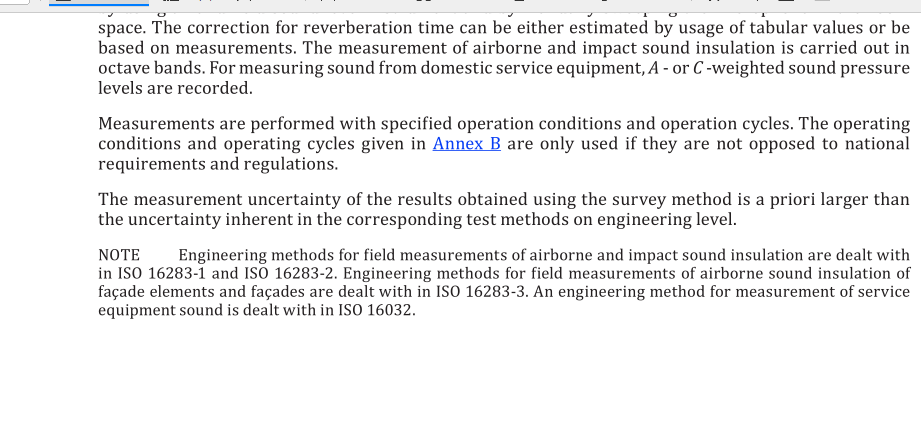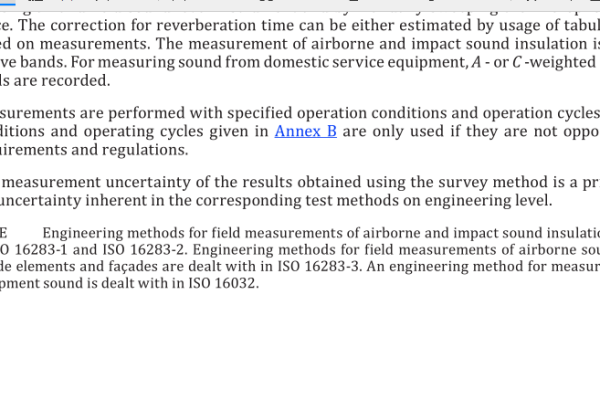ISO 10052:2021 pdf download – Acoustics — Field measurements of airborne and impact sound insulation and of service equipment sound — Survey method.
No correction for background noise shall be applied. For measurements of the airborne sound insulation between rooms and the airborne sound insulation of façades using the loudspeaker method, the sound power of the source should be adjusted so that the sound pressure level in the receiving room (in each frequency band) is at least 6 dB higher than the background noise level. This shall be checked by switching the source on and off before starting the measurement. When measuring the airborne sound insulation of façades by the traffic sound method, the background noise level in the receiving room cannot easily be assessed. Because of this, steps should be taken to ensure that the noise level in the receiving room due to sources within the building is as low as practicable. Excessive background noise from internal sources will lead to an underestimate of the façade insulation. A comment shall be made in the report if this is thought to have occurred. 6.2.2 Airborne sound insulation between rooms The sound generated in the source room shall be steady and have a continuous spectrum in the frequency range considered. Filters with a bandwidth of one octave may be used. When using broad- band noise, the spectrum of the sound source may be shaped to ensure an adequate signal-to-noise ratio at high frequencies in the receiving room. If the sound source enclosure contains more than one loudspeaker operating simultaneously, the loudspeakers shall be driven in phase. Multiple sound sources may be used simultaneously providing they are of the same type and are driven at the same level by similar, but uncorrelated, signals. Place the sound source in a corner of the room opposite the separating element. The distance from the walls shall be at least 0,5 m. If the source is a single loudspeaker system it should be placed facing the corner. When testing rooms in a vertical direction, use the lower room as the source room. When testing rooms of unequal size in a horizontal direction, use the larger room as the source room unless it has been previously agreed that the test should be in the other direction. 6.2.3 Impact sound insulation between rooms The impact sound shall be generated by the standard tapping machine and/or rubber ball (see ISO 10140-5 and ISO 16283-2). The standard impact sound sources; tapping machine and rubber ball, shall be placed in the source room near the centre of the floor (in case of tapping machine on the diagonal direction). This single position is sufficient if the floor and slab are isotropic. NOTE In complex cases, see numerous examples of room arrangements and measurement positions in ISO 16283-2:2020, Annex E. In the case of anisotropic floor constructions (with ribs, beams, etc.) add two positions so that the three positions are randomly distributed over the floor area. The hammer connecting line should be orientated at 45 o to the direction of the beams or ribs. In these cases, the distance of the tapping machine from the edges of the floor shall be at least 0,5 m. 6.2.4 Airborne sound insulation of façades The airborne sound insulation of façades is measured using an outside loudspeaker or road traffic sound. The room behind the façade serves as the receiving room.
ISO 10052:2021 pdf download – Acoustics — Field measurements of airborne and impact sound insulation and of service equipment sound — Survey method






